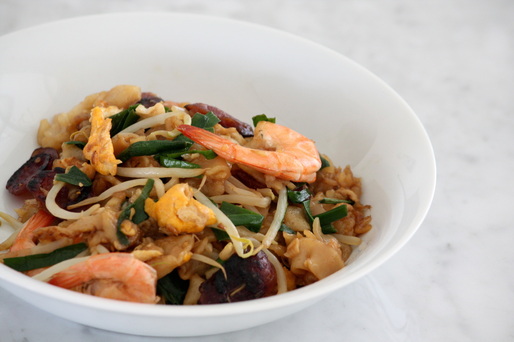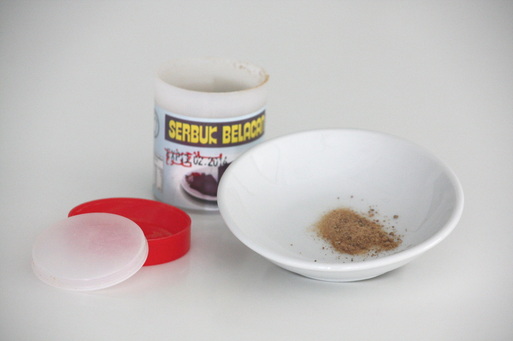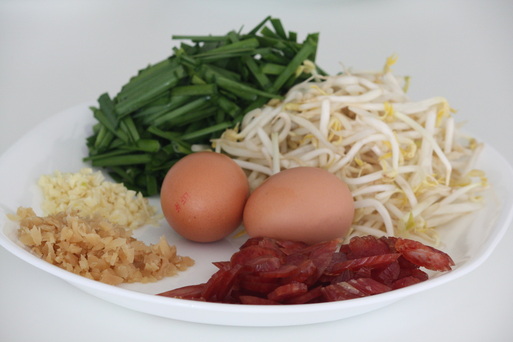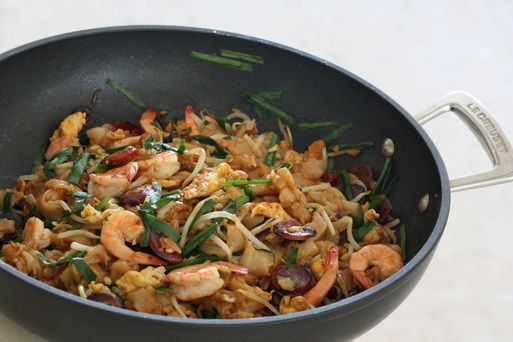That's it! You've nailed it. For our non-Malaysian/Singaporean friends, the aunty at the hawker stall would be so proud of you. For the uninitiated, char kway teow (in Hokkien/Fujian dialect) literally translates to fried rice-noodle strips.
Two weeks ago, I fried my first plate of char kway teow at Bayan Indah's beautiful kitchen. I loved that precious few minutes of frying in a well-seasoned wok, with detailed guidance from my thoughtful instructor Pick Shan. With that little punchy boost to my culinary self-esteem, I went home wanting to make the ideal plate of char kway teow. Ideal in my book, at least.
So I wrote in my scribble book, "What makes a good CKT?" and here is a compilation of my thoughts.
A good plate of CKT has to look sumptuous. So its ingredients must come in generous but well-balanced proportions. I'd love one with bean sprouts, chives and preserved radish in every mouthful. It should also come with at least medium-sized prawns, not any smaller. In terms of taste - and this is where Singaporeans and Malaysians differ - it is more savoury on the whole, with little bursts of natural sweetness coming from the lap-cheong and friends.
Since we eat with our eyes first, a good plate of CKT must be cooked beautifully to whet one's appetite. Therefore it must not be a plate of wet, dark sauce-bombed mess that looks... dead. On the contrary, one should be able to identify the ingredients, all fresh-looking (as opposed to soggy overcooked bean sprouts and chives) in each of its natural colours. The prawns would be reddish pink, the scrambled eggs yellow, the bean sprouts still looking crunchy along the white parts, bright green chives, not forgetting the lap-cheong in shiny dark red, slightly burned only as proof that it is the longest-surviving ingredient.
- I don't have a wok. BUT I have my precious heavy-gauged toughened non-stick shallow pan that conducts and retains heat evenly. This translates into less oil and zero-scraping. Sorry, CKT, I love my LC more than I do you.
- I don't have belacan, a key ingredient that makes CKT Malaysian, and have no intentions of making it a pantry staple. Why? Because I am more likely to live outside Malaysia and I don't want to be blacklisted by potential neighbours. But I count myself lucky to have discovered belacan powder. Although it is no match to a solid block of belacan, this tiny plastic jar (read: urban dweller-friendly) will easily follow me wherever we go next.
- I can't be cooking single portions all the time. What makes CKT so good at the hawker stall is largely because it is cooked-to-order. It is rarely cooked in large quantities, well, at most, two portions at a go. That's one luxury a home cook cannot afford. But I'll limit to just four generous portions for the recipe.
- I'm not a professional. I don't spend my days frying CKT for a living. In fact, it will be my first attempt at home, from scratch. (One of the perks of a cooking class is that most of the ingredients had been prepared for you. You just learn to cook it.) All I want is a recipe I could do to satisfy any CKT craving, especially when we live elsewhere next time. So cut me some slack while I give it my best shot.
Serves 4
Ingredients:
For the sauce
1 tablespoon dark soy sauce
1 tablespoon light soy sauce
2 tablespoons water
2 teaspoons sugar
1/2 teaspoon salt
1 teaspoon belacan powder
1 tablespoon oil
16 medium prawns, peeled and deveined
2 Chinese sausages (lap cheong), sliced
3 garlic cloves, chopped
2 tablespoons preserved radish (chai por)
500 g fresh kway teow, loosened into individual strips, rinsed lightly and drained
2 eggs
150 g bean sprouts
100 g chives, cut into 3 cm strips
1. Heat 1/2 tablespoon oil on medium-high heat and fry the prawns until opaque for 5 minutes. Set aside.
2. Reduce the heat to medium and add the lap cheong, spreading the slices on a single layer to render its fat. Toss the slices and re-spread regularly to prevent burning.
3. When the pan is well lubricated with the lap cheong fat, add the garlic and preserved radish. Toss the ingredients until the garlic starts to brown.
4. Add the kway teow and increase to high heat. Pour the sauce mixture over the kway teow and toss to coat the noodles strips evenly.
5. Push the kway teow to one side of the pan. On the empty side, add the remaining oil (1/2 tablespoon) and break the eggs over it. Using the spatula, break the egg yolks to mix with the whites, allowing the mixture to set lightly. Cover the eggs with the kway teow and toss to mix both noodles and eggs evenly.
6. Add the bean sprouts, chives, and cooked prawns, tossing them quickly with the kway teow. Serve immediately either on individual plates or a large serving plate. (This prevents the bean sprouts and chives from turning soggy due to the heat of the pan.)





